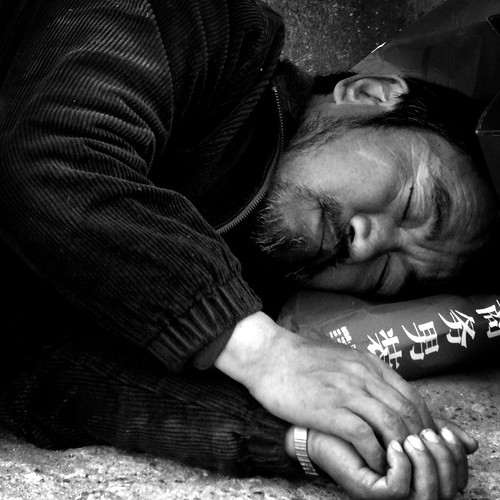
Here is a brief paper I wrote back in January regarding the social and political perspectives the U.S. and China carry.
Homelessness is a plague afflicting both the United States & China. However, despite efforts to reduce it in both countries, it is still a pertinent issue today dealt with in a variety of ways. Despite America’s traditionally strong social attitude that the poor are “undeserving”, America’s political policies regarding poverty reduction are more effective than China’s.
According to Herbert Gan’s The War Against the Poor, Americans have a general social notion that the homeless are “undeserving” and thus reflect this in their attitudes toward the homeless. Homelessness, often stereotypically connected with drinking, laziness, and drug abuse, conjures up an image of an American that waits for the government to take action for him. Thus, many Americans are set against the homeless and do not take action for poverty reduction. The cause for this stereotypical image of the homeless as mentally ill and drug-abusing people is made clearer in Raven Tyler’s piece on “Homeless in America.” Here, she states that during the 1980s, thousands of Americans were released from psychiatric hospitals and left on the streets without homes. Thus, many Americans today conjure up this kind of an image for the homeless.
This social attitude of distaste for the homeless is further enhanced by the Nashville Sessions Players’ depiction of society’s reaction to the homeless. In their song, “Teardrops of Blood”, although the character Leroy, a war veteran and homeless man, is clearly in need of help, the rich man, preacher man, and sinners ignore his cry of help as “teardrops of blood fall”. Furthermore, in Ted Rall’s political cartoon, “Society is a Carnivorous Flower”, reactions to people that are merely homeless and not injured can be seen. When two spectators suspect a woman of being injured and homeless, there is a sympathetic reaction. But merely being homeless warrants nothing. Paralleling this emotional reaction to a political one, government funds for programs like Medicaid, a program helping low-income people receive medical care, has increased over the years while actual government funding of low-income housing has decreased. People regard medical care of those in poverty above the issue of mere homelessness.
Despite this negative social attitude towards the homeless, democratic political action in America regarding homelessness today are diverse and widespread, including antipoverty programs like the usage of food stamps, Medicaid, and housing. According to Rebecca Blank’s book, It Takes A Nation, food stamps and Medicaid are the most widely used programs. However, Erik Eckholm’s news article, “New Campaign Shows Progress for Homeless”, shows that housing assistance is also gaining ground. The “housing first” policy advocated by the Bush administration has been adopted in 219 cities nationwide to implement the 10-year plan for stopping chronic homelessness. Victims of homelessness live in free housing until they get a job and start to slowly pay the rent. Results have been very successful despite decreased federal funds for low-income housing: 26% in Dallas, 28% in San Francisco, & 60% in Philadelphia.
The Chinese communist government, in contrast, has increased investments to improve production and better the living conditions, especially in rural China. It used the expanding economy to reduce poverty by increasing the income of households. According to the “World Bank Says China is Poverty Reduction Model” article, China reduced the number of people in poverty from 250 million in 1978 to 29.27 million in 2001; however, this number has raised some controversy due to China’s relatively low poverty standard. And according to Howard French’s 2008 article, “Lives of Poverty, Untouched by China’s Boom”, a more recent study implies that 300 million people are still poor in China; some people have not been affected by China’s economic boom, despite what the government may have hoped. Moreover, Shujie Yao’s scholarly article, “Economic Development & Poverty Reduction in China over 20 Years of Reform”, shows that corrupt behaviors of local governments as well as the remote location of some areas leave them in continual poverty as they remain untouched by the economic expansion. However, the “Income Distribution in Urban China During the Period of Global Economic & Globalization” article shows that political reforms through the economy has proven unsuccessful even in busy urban areas, where the slow increase in the income of urban households in comparison to the Gross Domestic Product (GDP) has continued poverty.
Thus, despite the supposed steep reduction of poverty in China, the figures associated with this occurrence are questionable, while the U.S. has achieved concrete results. This suggests that direct reform of political parties rather than the political push of the economy would benefit society more.



